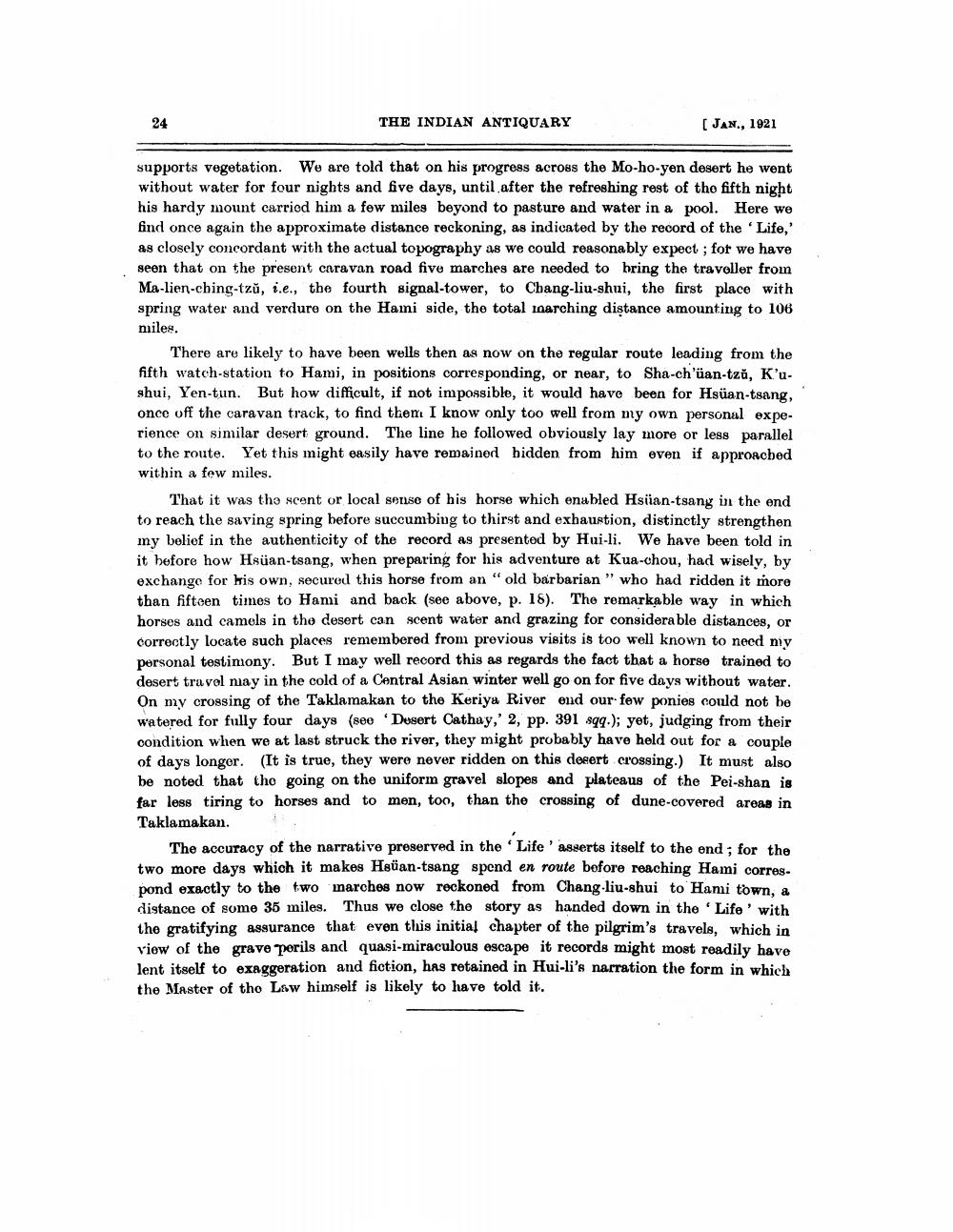________________
24
THE INDIAN ANTIQUARY
[ JAN., 1921
supports vegetation. We are told that on his progress across the Mo-ho-yen desert he went without water for four nights and five days, until after the refreshing rest of the fifth night his hardy mount carried him a few miles beyond to pasture and water in a pool. Here we find once again the approximate distance reckoning, as indicated by the record of the 'Life, as closely concordant with the actual topography as we could reasonably expect; fot we have seen that on the present caravan road five marches are needed to bring the traveller from Ma-lien-ching-tzū, i.e., the fourth signal-tower, to Chang-liu-shui, the first place with spring water and verdure on the Hami side, the total marching distance amounting to 106 niles.
There are likely to have been wells then as now on the regular route leading from the fifth watch-station to Hami, in positions corresponding, or near, to Sha-ch'uan-tză, K'ushui, Yen-tun. But how difficult, if not impossible, it would have been for Hsüan-tsang, once off the caravan track, to find them I know only too well from my own personal experience on similar desert ground. The line he followed obviously lay more or less parallel to the route. Yet this might easily have remained hidden from him even if approached within a few miles.
That it was the scent or local sense of his horse which enabled Hsian-tsang in the end to reach the saving spring before succumbing to thirst and exhaustion, distinctly strengthen my belief in the authenticity of the record as presented by Hui-li. We have been told in it before how Hsuan-tsang, when preparing for his adventure at Kua-chou, had wisely, by exchange for his own, secured this horse from an "old barbarian " who had ridden it more than fifteen times to Hami and back (see above, p. 18). The remarkable way in which horses and camels in the desert can scent water and grazing for considerable distances, or correctly locate such places remembered from previous visits is too well known to need niy personal testiniony. But I may well record this as regards the fact that a horse trained to desert travel may in the cold of a Central Asian winter well go on for five days without water. On my crossing of the Taklamakan to the Keriya River end our few ponies could not be watered for fully four days (see Desert Cathay,' 2, pp. 391 sqq.); yet, judging from their condition when we at last struck the river, they might probably have held out for a couple of days longer. (It is true, they were never ridden on this desert crossing.) It must also be noted that the going on the uniform gravel slopes and plateaus of the Pei-shan is far less tiring to horses and to men, too, than the crossing of dune-covered areas in Taklamakan.
The accuracy of the narrative preserved in the 'Life' asserts itself to the end; for the two more days which it makes Heüan-tsang spend en route before reaching Hami corres. pond exactly to the two marches now reckoned from Chang-liu-shui to Hami town, a distance of some 35 miles. Thus we close the story as handed down in the 'Life' with the gratifying assurance that even this initial chapter of the pilgrim's travels, which in view of the grave perils and quasi-miraculous escape it records might most readily have lent itself to exaggeration and fiction, has retained in Hui-li's narration the form in which the Master of tho Lsw himself is likely to have told it.




